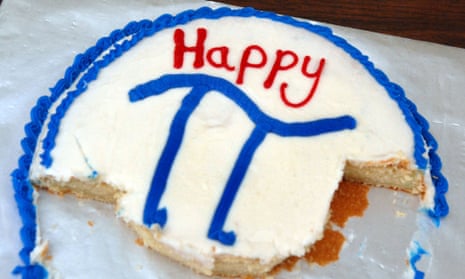A date falls on this Saturday that only comes once every 100 years – and geeks around the world are very excited.
It’s Pi Day, the celebration date of the number that is the ratio of a circle’s circumference to its diameter. The celebration is held annually on 14 March, because 3/14 spells out the first three digits of π, or pi, which is 3.14.
But it’s not just any Pi Day. This year is the first time in a century that the date (by the US calendar) is 3/14/15, which describes the first five digits of pi, 3.1415. Mass elation will peak at 9.26:53am when the date and time will describe pi to 10 digits.
Originally a US-based initiative to promote mathematics to pupils, Pi Day has in recent years transformed into a kind of nerd Christmas, commemorated all over the world by children and adults – often by eating pie.
At Morriston comprehensive school in Swansea pupils on Friday brought in pies as one of many maths-themed activities. “It’s the first time we’ve done Pi Day, but I think it’s here to stay,” said maths teacher Philip Jones. “We’re always trying to encourage maths as more than numbers, and this is fun. It’s nice for maths to have something that is just our day.”
Events in Wales have been encouraged by the Welsh government, which declared it Pi Day Cymru as a way of honouring the Anglesey-born mathematician William Jones, who came up with the idea of pi in 1706.
Jones was not the first person to realise that the circumference of a circle divided by the diameter is a number that defies easy calculation. But he was the first to denote the ratio by the symbol π, suggesting it in a book as an abbreviation of either the word periphery or perimeter.
The root of fascination with pi is the fact that the ratio of the circle’s two simplest measurable quantities – the distance around it and the distance across it – produces a number that is so complicated: its digital expansion continues for ever, churning out a sequence of digits with no apparent pattern.
The contrast between the simplicity of the definition and the complexity of the result has helped turn pi into an iconic cultural symbol. It is a metaphor for the mysteries of mathematics – glorified in many ways, in a song by Kate Bush, a film by Darren Aronofsky and even a perfume by Givenchy.
Mathematicians have turned the search to find more and more digits of pi into an epic quest. Archimedes got to two decimal places in the third century BC. Now pi is known to 13.3tn decimal places, a result announced online in October by an anonymous computer scientist using the name Houkouonchi.
Quite apart from its role in science, however, pi is also the only number that has inspired its own literary genre, “pilish”, in which the length of words in a sentence is determined by pi’s digits. For example:
It’s a bash, a party: celebrate pi!
The first word has three letters, the second one, the third four, and so on. The Shakespeare of this style is American Mike Keith whose novella Not a Wake follows pi for 10,000 digits.
Pi has also inspired a competitive sport: pi memorisation, where practitioners must recite as many digits in pi from memory. Akira Haraguchi, 69, from Japan, claims to have set a new record by reciting 100,000 digits in public – which took him 16hr 30min. “To me, reciting pi’s digits has the same meaning as chanting the Buddhist mantra and meditating,” he says. “Everything that circles around carries the spirit of the Buddha. I think pi is the ultimate example of that.” The official Guinness World record is held by Chao Lu, from China, who recited pi to 67,890 places.
Writing in pilish and pi memorisation competitions are common ways to celebrate Pi Day, but the most popular activities usually involve the eating of pies, an appropriate pun since pies are often circular. In the US, where Pi Day still has the highest visibility, shops embracing the event are pricing pies at $3.14.
Another happy coincidence is that 14 March is Albert Einstein’s birthday, which adds a scientific respectability to the festivities. In Princeton, New Jersey, where Einstein lived for the last two decades of his life, Pi Day is one of the biggest days of the year, with dozens of events including a parade, pie-throwing and an Einstein lookalike competition.
Northfleet school for girls in Gravesend, Kent, has celebrated Pi Day for the last few years, says science teacher Julie Davis. “It is definitely becoming a bigger deal. What’s nice about pi is that it’s universal – everybody uses the same symbol.”
Because Pi Day this year falls on a Saturday, most school activities take place on Friday. Sue Thaw, maths teacher at St Bede’s Inter-Church school in Cambridge, asked her students to compose “piems”, poems in pilish. “Pi day is a great way of engaging students and getting them to explore maths in a different way. I’ll be doing it again next year.”
Alex Bellos is the author of Alex’s Adventures in Numberland and Alex Through the Looking-Glass.



